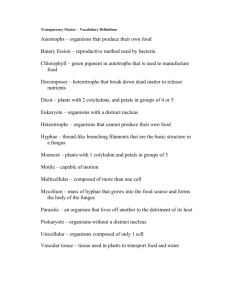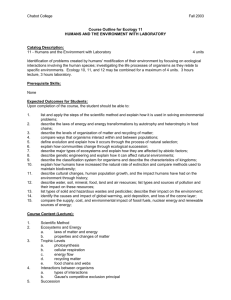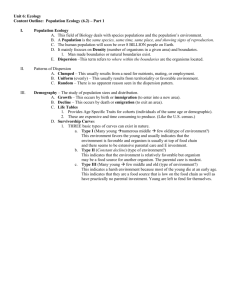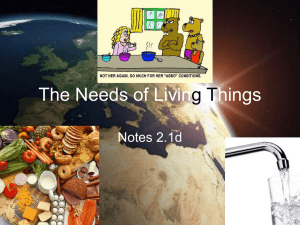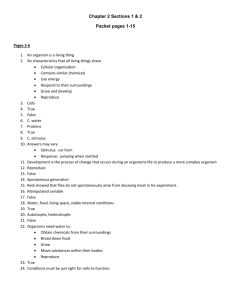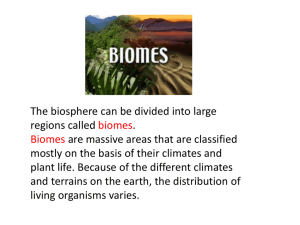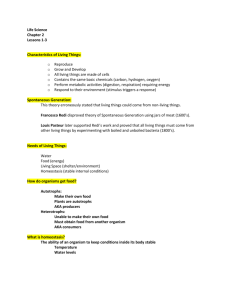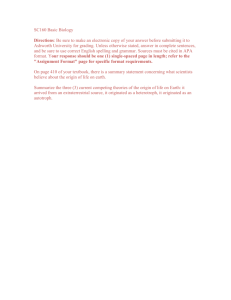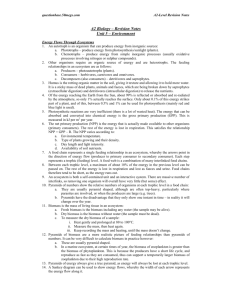Ecology Unit Review Topics Ecology Study of interactions between
advertisement
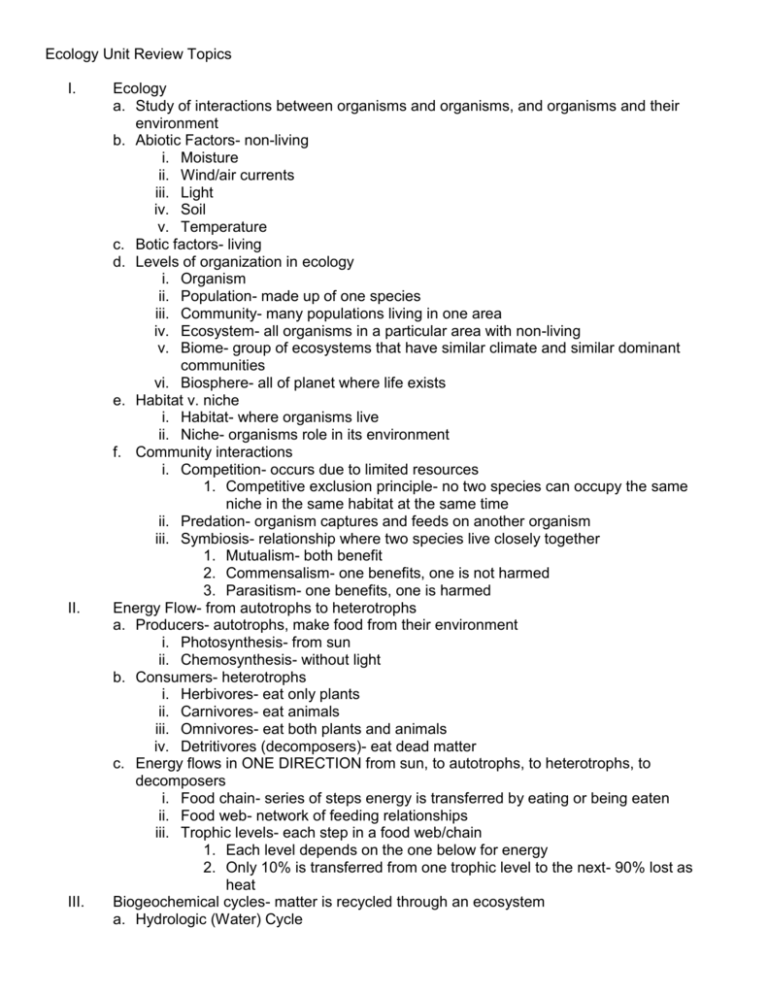
Ecology Unit Review Topics I. II. III. Ecology a. Study of interactions between organisms and organisms, and organisms and their environment b. Abiotic Factors- non-living i. Moisture ii. Wind/air currents iii. Light iv. Soil v. Temperature c. Botic factors- living d. Levels of organization in ecology i. Organism ii. Population- made up of one species iii. Community- many populations living in one area iv. Ecosystem- all organisms in a particular area with non-living v. Biome- group of ecosystems that have similar climate and similar dominant communities vi. Biosphere- all of planet where life exists e. Habitat v. niche i. Habitat- where organisms live ii. Niche- organisms role in its environment f. Community interactions i. Competition- occurs due to limited resources 1. Competitive exclusion principle- no two species can occupy the same niche in the same habitat at the same time ii. Predation- organism captures and feeds on another organism iii. Symbiosis- relationship where two species live closely together 1. Mutualism- both benefit 2. Commensalism- one benefits, one is not harmed 3. Parasitism- one benefits, one is harmed Energy Flow- from autotrophs to heterotrophs a. Producers- autotrophs, make food from their environment i. Photosynthesis- from sun ii. Chemosynthesis- without light b. Consumers- heterotrophs i. Herbivores- eat only plants ii. Carnivores- eat animals iii. Omnivores- eat both plants and animals iv. Detritivores (decomposers)- eat dead matter c. Energy flows in ONE DIRECTION from sun, to autotrophs, to heterotrophs, to decomposers i. Food chain- series of steps energy is transferred by eating or being eaten ii. Food web- network of feeding relationships iii. Trophic levels- each step in a food web/chain 1. Each level depends on the one below for energy 2. Only 10% is transferred from one trophic level to the next- 90% lost as heat Biogeochemical cycles- matter is recycled through an ecosystem a. Hydrologic (Water) Cycle IV. V. VI. i. Precipitationpercolationwater flowevaporation/transpiration condensation b. Carbon cycle i. Carbon dioxide in atmosphere 1. Released by combustion, respiration, decomposition 2. Removed by photosynthesis ii. Sediments (fossils/fossil fuels) are main reservoir c. Nitrogen cycle i. Used in amino acids and nucleic acids ii. Main reservoir is nitrogen gas in atmosphere iii. Decomposers convert nitrogen into usable form for plants (nitrogen fixation) and add back to atmosphere (denitrification) d. Phosphorus cycle i. Used for phospholipids and nucleotides ii. Cycle exists in earth’s crust- not in atmosphere iii. Added to soil from living organisms by waste products Communities a. All the populations that live in a habitat- structure determined by type of habitat b. Limiting factors i. Food ii. Predators iii. Temperature c. Changes to a community- ecological succession i. Primary- no preexisting soil, usually after volcano eruption, earthquake ii. Secondary- preexisting soil, usually after natural disaster (fire, flood) iii. Pioneer species- those that colonize barren habitats (i.e. lichens) iv. Climax community- stable community that remains unchanged over time v. Pioneer stage Climax Community Biogeography- study of distribution of organisms and factors that contribute to distribution a. Geologic history b. Topography c. Climate (average weather in a region) d. Soil characteristics e. Species interactions Population ecology a. Sampling- to get best estimate of population size i. Random ii. Non-random b. Factors that affect population size i. Birth, death ii. Immigration iii. Emigration c. Population growth i. Exponential- no limits, “J” curve ii. Logistic- limits (carrying capacity), “S” curve d. Environmental limits on populations i. Density-dependent: disease, food, parasitism, predation, competition ii. Density-independent: temperature, storms, floods, drought, habitat disruption e. Human population growth (Demography) i. Reached exponential because of industrial revolution ii. Age structure pyramids- compare age structure of populations of different countries

